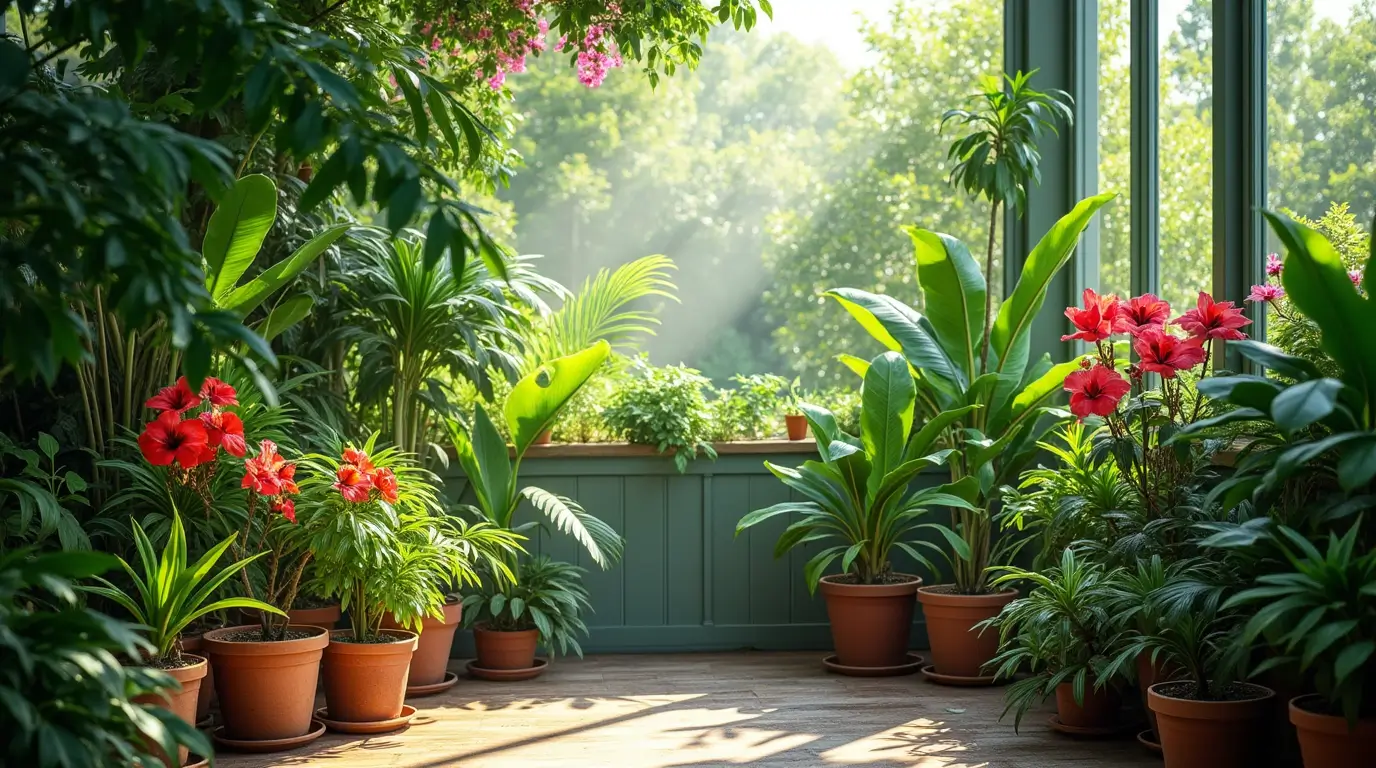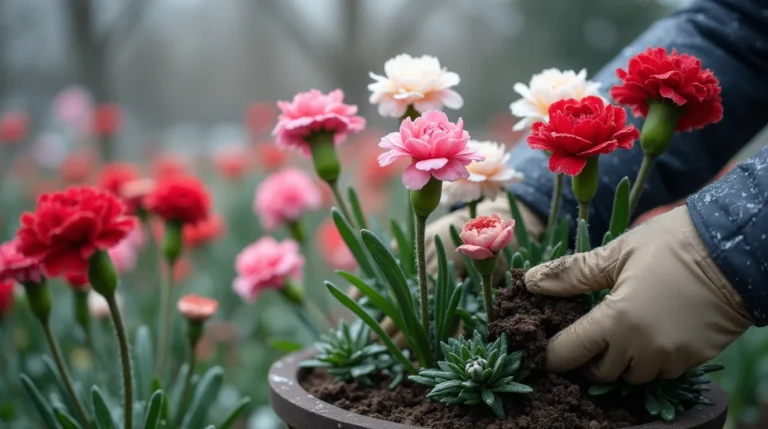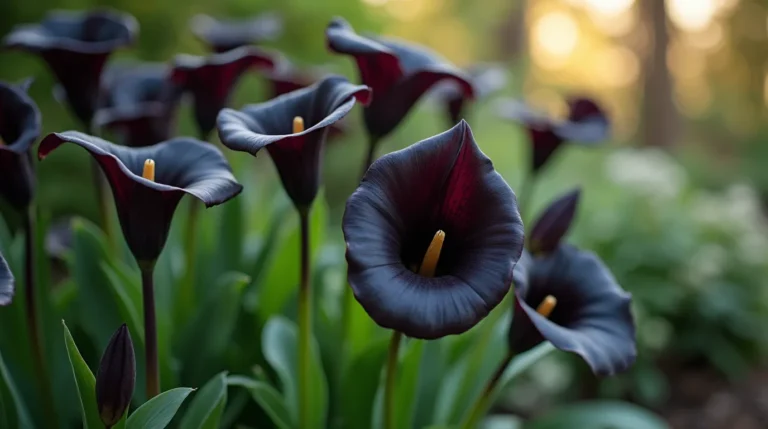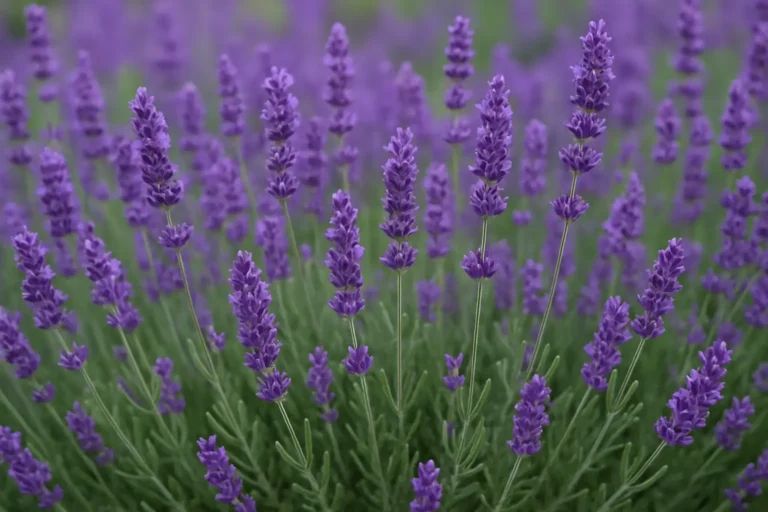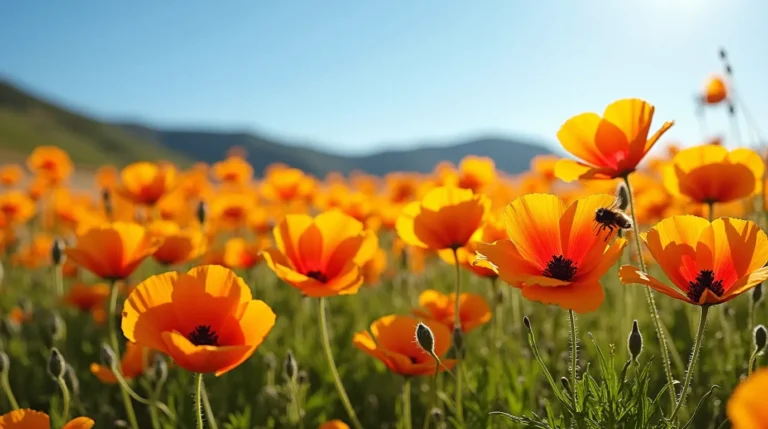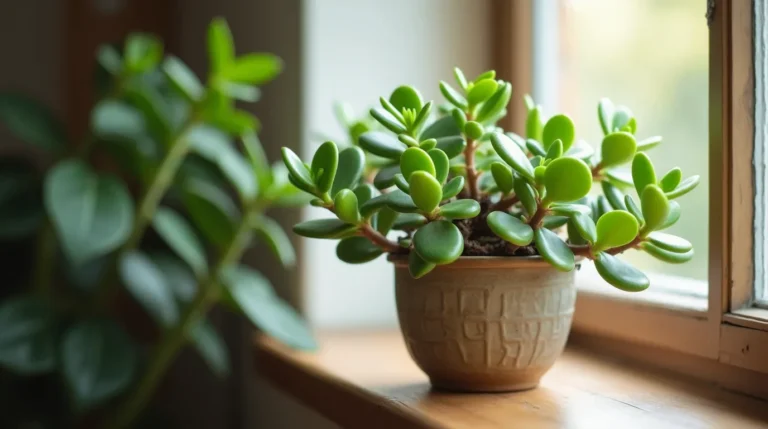Tropical Plants 101 : Everything You Need To Know To Get Started
Starting with tropical plants is exciting. It lets you bring a bit of the exotic into your home or garden. These plants are known for their lush greenery and bright colors. They add visual interest to any space.
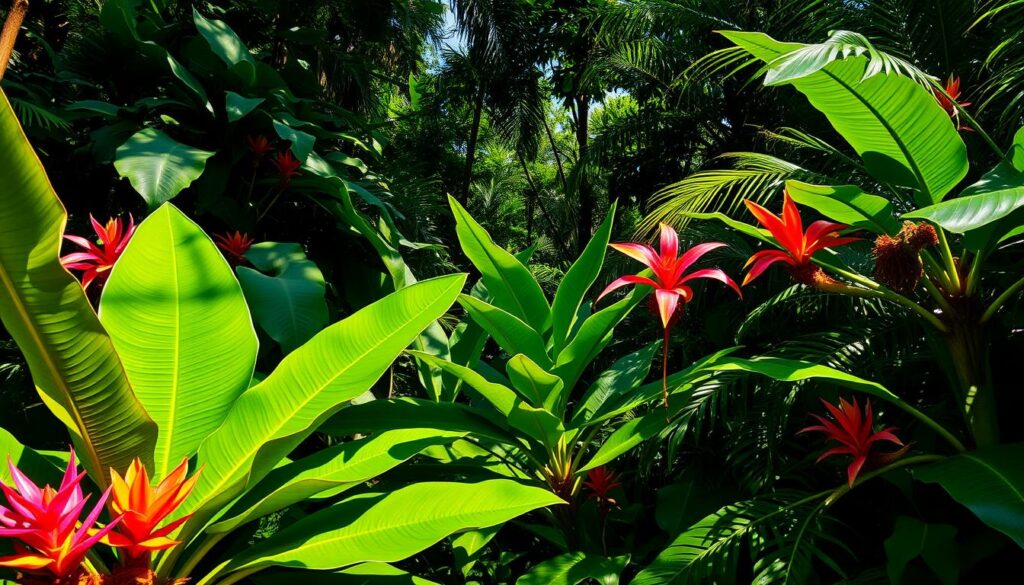
If you want a tropical oasis in your backyard or some tropical flair indoors, this guide is for you. We’ll cover the basics of tropical plants and how to care for them. You’ll become a confident tropical plant enthusiast.
Key Takeaways
- Understanding the basics of tropical plants is essential for their growth and maintenance
- Tropical plants can thrive in a variety of environments, from indoor spaces to outdoor gardens
- Getting started with tropical plants requires knowledge of their natural habitat and care requirements
- Tropical plants can add visual interest and beauty to any space
- Proper care and maintenance are crucial for the health and longevity of tropical plants
- Tropical plants can be a great way to create a unique and exotic atmosphere in your home or garden
Understanding Tropical Plants and Their Natural Habitat
Tropical plants come from the tropics, where it’s hot and humid. They live near the equator. These plants love sunlight and rain, making them perfect for warm, humid places.
Their home ranges from rainforests to deserts. Each place has its own plants, ready for its own weather. For instance, rainforest plants do well in the dark. Desert plants can survive with little water.
Characteristics of Tropical Plants
- High-temperature tolerance
- High humidity requirements
- Abundant sunlight needs
- Adaptation to well-defined wet and dry seasons
To grow tropical plants, you need to know their home. By mimicking their natural habitat, you can help your plants flourish.
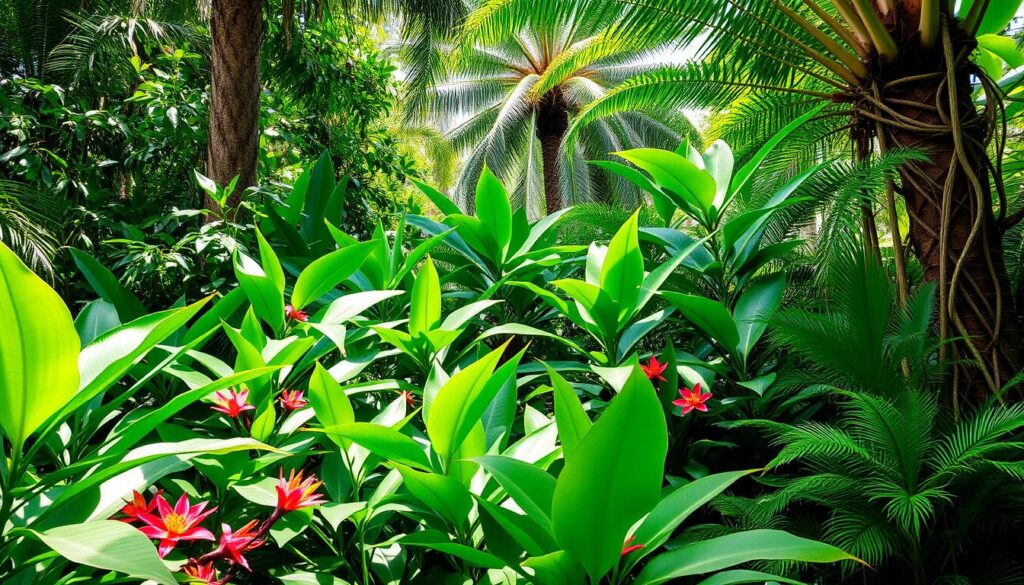
Benefits of Growing Tropical Plants in Your Space
Adding tropical plants to your space can improve air quality and keep humidity levels up. The benefits of tropical plants go beyond their beauty. They help make your living space healthier by purifying the air. They absorb carbon dioxide and release oxygen, making them perfect for any room.
Some of the key benefits of growing indoor tropical plants include:
- Improved air quality
- Increased humidity, which can be beneficial for skin health and respiratory issues
- Natural sound barriers
- Reduced stress levels due to their calming, natural ambiance
It’s easy to see why indoor tropical plants are so popular. They can purify the air, create a calm atmosphere, or simply add beauty to your space. They’re a great choice for any indoor area.
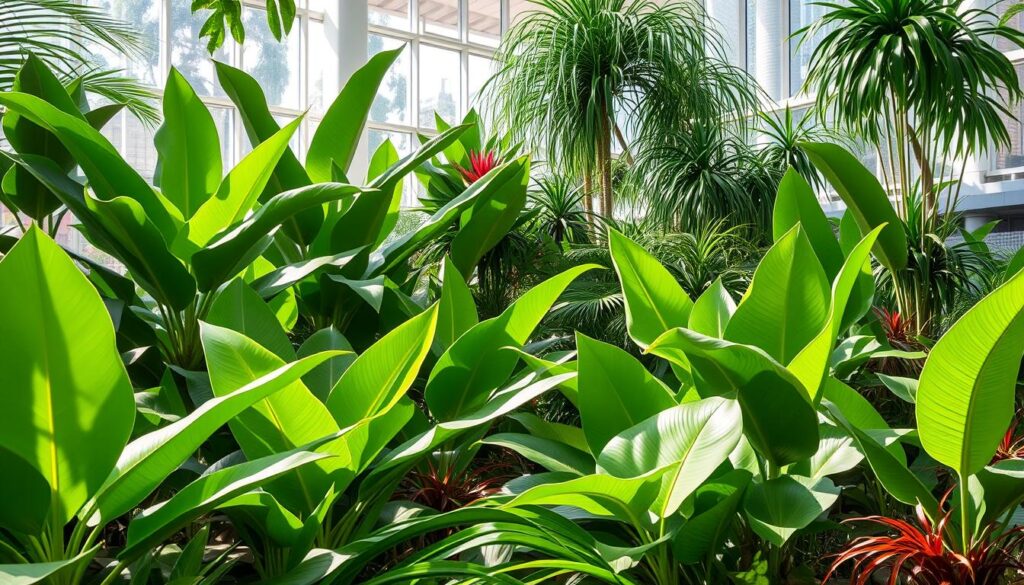
Choosing the right tropical plants can bring many benefits to your space. They can improve air quality and reduce stress. Indoor tropical plants help create a healthier, more relaxing home environment.
Essential Requirements for Growing Tropical Plants
To make sure your tropical plants do well, it’s important to know what they need. Each plant is different, so it’s key to understand their unique needs. The right conditions are crucial for their growth and survival.
Tropical plants need specific things to thrive. Knowing what they need helps you create a good environment for them. This includes the right light, temperature, and humidity.
Light Requirements
Light is very important for tropical plants. Some need direct sunlight, while others prefer shade. It’s important to find out what your plants need to get the right amount of light.
Temperature Needs
Temperature is also very important. Most tropical plants like temperatures between 65°F and 95°F. Keeping the temperature in this range is key for their growth and survival.
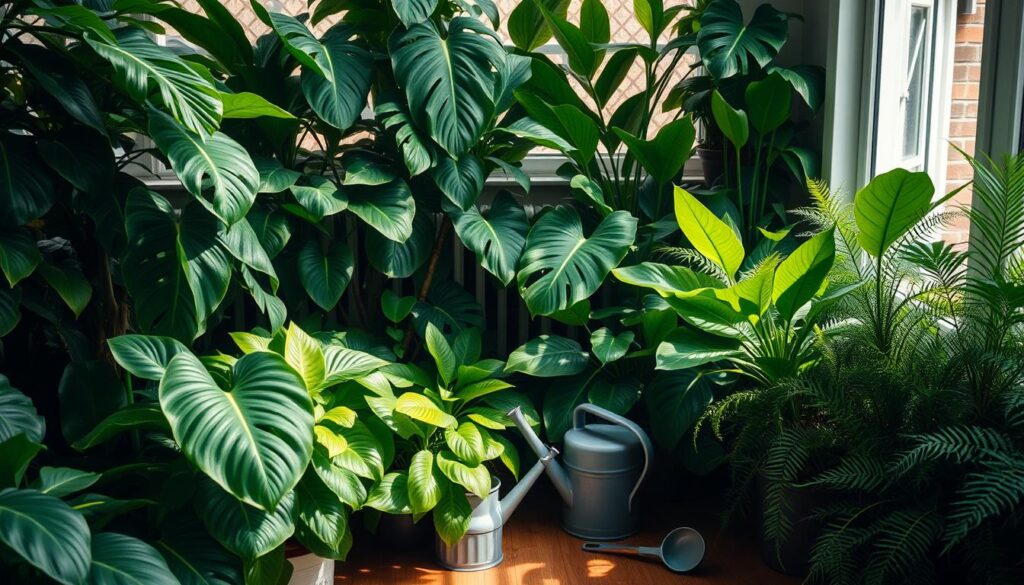
Humidity Levels
Humidity levels should be between 40% and 70% for tropical plants. You can use a humidifier or group plants together to keep the humidity right.
Soil Conditions
The soil should drain well to prevent root rot. It should also have a pH level that fits the plant. By meeting these needs, you can create a great environment for your tropical plants. This makes caring for them and meeting their needs easier.
Choosing the Right Location for Your Tropical Plants
Where you place your tropical plants matters a lot for their health and growth. Make sure the plant gets the right amount of light. For example, plants that love humidity do well near a tray with water and pebbles.
When picking a spot for your tropical plants, keep these things in mind:
- Light exposure: Most tropical plants need bright, indirect light to grow.
- Temperature fluctuations: Keep your plants away from drafts or extreme temperatures.
- Humidity levels: Grouping plants or using a tray with water and pebbles helps keep humidity up.
Choosing the right spot for your tropical plants is key. Proper placement helps them stay healthy and beautiful. This way, you can enjoy their unique looks and benefits.

Think about how the location looks too. Pick a spot that highlights the plant’s beauty and fits with your decor. With the right spot and care, your tropical plants can add exotic beauty and freshness to your space.
| Location | Light Requirements | Humidity Levels |
|---|---|---|
| South-facing window | Bright, indirect light | Medium to high humidity |
| East- or west-facing window | Medium, indirect light | Medium humidity |
| North-facing window | Low, indirect light | Low to medium humidity |
Best Tropical Plants for Beginners
Choosing the right tropical plants for beginners is key. Look for species that are easy to care for and can grow well in different places. Plants like the Prayer Plant, Peacock Plant, and Chinese Evergreen are great for indoor spaces. They have beautiful leaves and don’t need much care.
For outdoor spaces, consider plants like Bird of Paradise, Heliconia, and Bromeliads. These plants are not only beautiful but also easy to take care of. They’re perfect for beginners.
Easy-Care Indoor Options
- Prayer Plant: known for its beautiful foliage and low-maintenance
- Peacock Plant: adds a touch of tropical elegance to any room
- Chinese Evergreen: a low-maintenance plant with stunning leaves
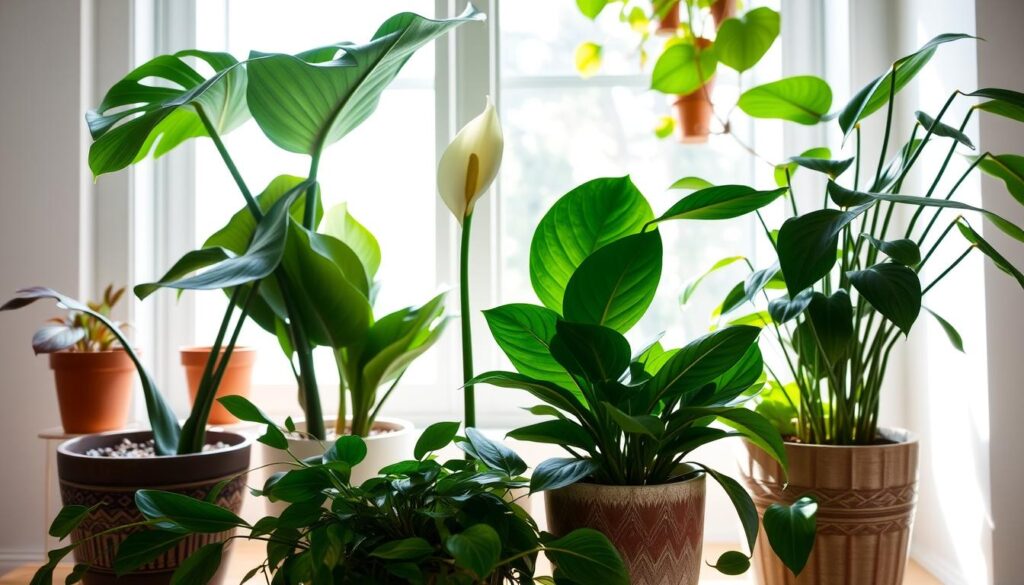
Pet-Safe Choices
If you have pets, picking pet-safe plants is important. Plants like Spider Plants, Parlor Palms, and Areca Palms are safe for pets. They also do well indoors, making them great for families with pets.
By picking the right tropical plants, you can make a beautiful indoor or outdoor space. These plants will grow well with the right care. They’ll make your home look lush and tropical.
Proper Watering Techniques for Tropical Plants
Watering is essential for tropical plants, and striking the right balance is key. Too much water can lead to root rot, while too little can cause stress. To check if your plant needs water, simply insert your finger into the soil up to the first knuckle. Water only when it feels dry to the touch.
Use room-temperature water when watering tropical plants to avoid shocking the roots. Keep these tips in mind:
- Water deeply, ensuring the pot drains properly to prevent water from stagnating in the soil.
- Avoid wetting the leaves or crown of the plant, as this can encourage rot and other issues.
- Opt for a well-draining potting mix to ensure excess water doesn’t accumulate in the soil.
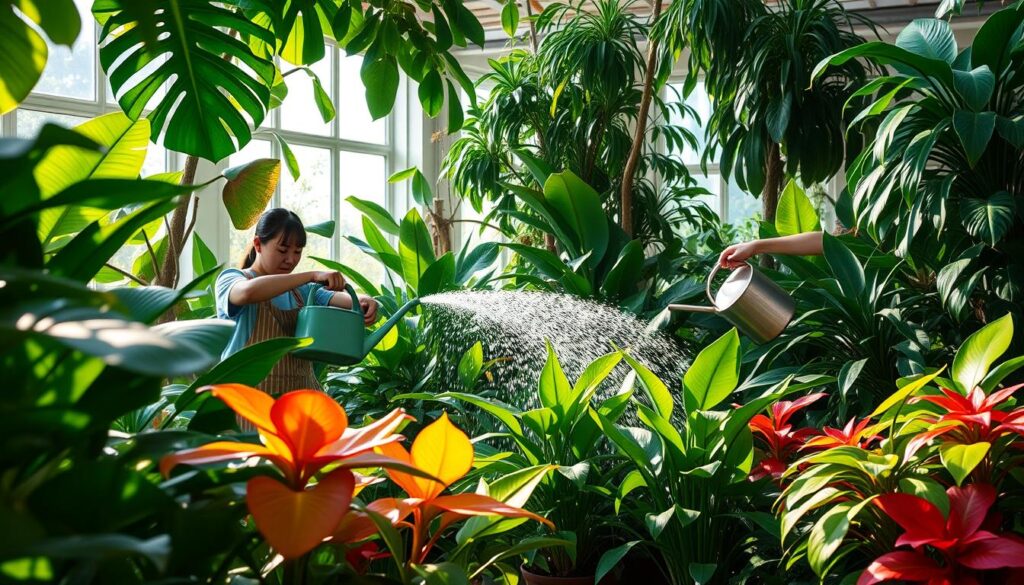
By following these tips and being mindful of your tropical plant’s watering needs, you can help ensure it stays healthy and thrives. Remember, tropical plant care is all about finding the right balance and providing your plant with the conditions it needs to succeed.
Fertilization and Nutrition Guidelines
Fertilizing tropical plants right is key for their growth. These plants need specific nutrients to thrive. Use a water-soluble fertilizer in spring and summer but at half strength to avoid harming the roots.
There are many fertilizers out there, like slow-release and organic ones. Knowing the differences helps you choose the best for your plants. Consider these points:
- Water-soluble fertilizers: These are quickly absorbed and work fast.
- Slow-release fertilizers: They give nutrients slowly, keeping plants fed steadily.
- Organic fertilizers: Made from natural stuff, they’re a green choice for feeding plants.
Spotting nutrient deficiencies is important for your plants’ health. Look for yellow leaves or slow growth. Adjust your fertilizing to prevent these problems and keep your plants healthy.
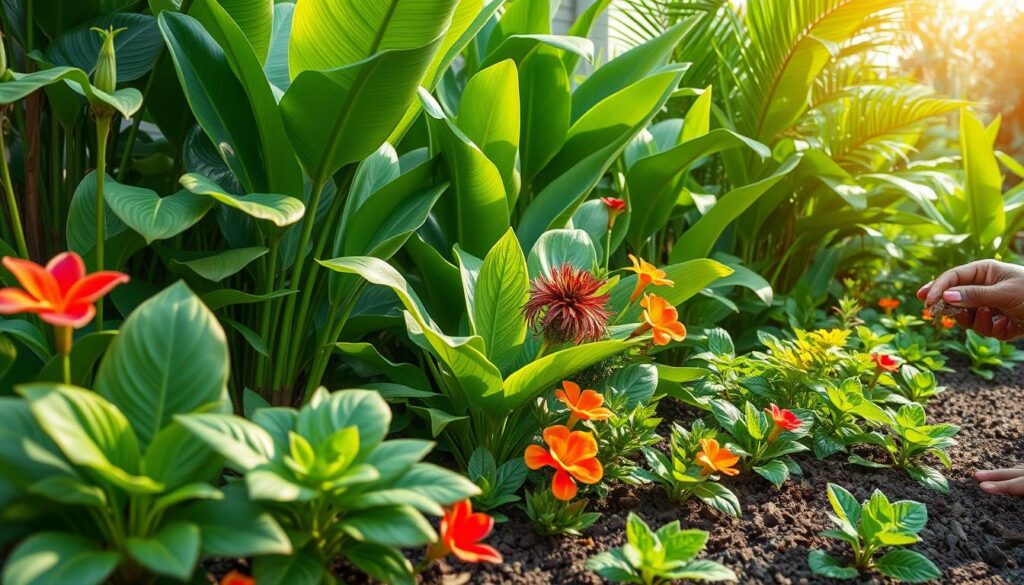
By following these tips, your tropical plants will thrive. Always read the fertilizer instructions and think about your plants’ needs. With the right care, you’ll enjoy the beauty and benefits of these plants.
| Fertilizer Type | Benefits | Drawbacks |
|---|---|---|
| Water-soluble | Quick results, easy to apply | Can burn roots if overapplied |
| Slow-release | Steady supply of nutrients, convenient | Can be more expensive |
| Organic | Sustainable, natural ingredients | Can be slower-acting |
Common Tropical Plant Problems and Solutions
Tropical plants face many issues like pests, diseases, and environmental stresses. These are common tropical plant problems that can be tough to fix. To avoid these problems, it’s key to give your plants the right care and maintenance.
Some pests that harm tropical plants include spider mites, mealybugs, and scale. You can fight these pests with insecticidal soap or neem oil. To stop fungal diseases, make sure your plants have good air flow and don’t get too wet.
Environmental stresses, like sudden temperature or light changes, can also harm plants. To help your plants adjust, slowly change their environment.
To spot and solve these issues, keep a close eye on your plants and act fast. Here are some common problems and how to fix them:
- Posts: Treat with insecticidal soap or neem oil
- Fungal diseases: Ensure good air circulation and avoid overwatering
- Environmental stresses: Gradually acclimate the plant to new conditions
Knowing about these tropical plant problems and how to prevent them is crucial. This way, you can keep your plants healthy and thriving. Always do your research to understand what your plants need for the best care.
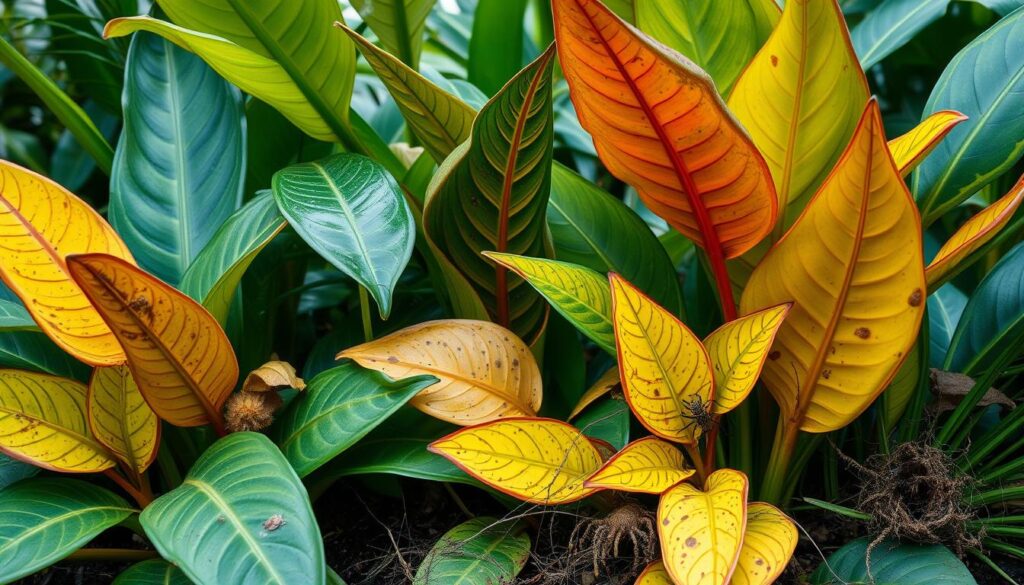
Pruning and Maintenance Tips
Pruning tropical plants is key to keeping them healthy and looking good. It’s important to prune at the right time. Spring and summer are usually the best months, when plants are growing fast.
Looking after tropical plants means paying close attention to details. Pruning is a big part of their care. You’ll need sharp scissors or pruning shears to do it right. This helps avoid spreading diseases and makes clean cuts.
Proper Pruning Techniques
When you prune, cut just above a node. A node is where a leaf meets the stem. Cutting at a 45-degree angle helps prevent water from collecting and reduces disease risk. These simple steps will help your tropical plants stay healthy and strong.
Some important things to remember when pruning tropical plants include:
- Prune during the active growing season
- Use the right tools to prevent disease
- Make clean cuts at a 45-degree angle
- Prune just above a node to promote healthy growth
By following these tips, you’ll become a pro at pruning and caring for tropical plants. Always put your plants’ health first. If you have any questions or concerns, don’t hesitate to ask.
| Plant Type | Pruning Frequency | Pruning Tips |
|---|---|---|
| Ferns | Every 2-3 months | Prune dead fronds to maintain appearance |
| Palm Trees | Every 6-12 months | Prune dead leaves to prevent disease |
| Bromeliads | Every 3-6 months | Prune dead flowers to encourage new growth |
Creating the Perfect Humidity Environment
To make a great home for tropical plants, you need the right humidity. Many tropical plants love humid air, needing levels up to 70%. Using a humidifier is a good idea, especially in dry places or when it’s cold.
Grouping plants together is another smart move. It creates a humid spot around them. You can also put your plant on a tray with water and pebbles. As the water evaporates, it makes the air around your plant more humid. This is great for plants like ferns and orchids that need lots of moisture.
Here are some tips for a humid home for your tropical plants:
- Use a hygrometer to check your home’s humidity
- Put plants on a tray with pebbles and water to boost humidity
- Group plants together to make a humid spot
- Don’t put plants near heating or cooling vents
By following these tips, you can make a humid home for your tropical plants. This will help them grow and thrive.
Seasonal Care for Tropical Plants
Tropical plants need special care in different seasons to grow well. As a plant owner, knowing what your plants need in each season is key. The right seasonal care for tropical plants can greatly improve their health and life span.
In winter, keeping your plants warm is vital. You can move them inside, use frost blankets, or add extra heat. For summer, focus on keeping them moist and cool.
Winter Protection
- Bring plants indoors to a warm location
- Use frost blankets to protect plants from frost
- Provide supplemental heating to maintain a warm temperature
Summer Care
- Ensure adequate moisture by watering plants regularly
- Protect plants from extreme heat by providing shade
- Monitor temperature and humidity levels to prevent stress
By following these tropical plant seasonal tips, your plants will do great all year. Always check the specific needs of your plants, as some are different. With the right care, your tropical plants will add beauty and life to your space.
| Season | Care Requirements |
|---|---|
| Winter | Protection from cold temperatures |
| Summer | Adequate moisture and protection from extreme heat |
| Transitional Periods | Careful management of temperature and humidity changes |
Propagation Methods for Tropical Plants
Propagating tropical plants is a fun way to share with friends or grow your collection. There are many ways to do tropical plant propagation. These methods help you make new plants from ones you already have. It’s a cost-effective and rewarding process.
Common methods include division, layering, and leaf or stem cuttings. Division splits a mature plant’s roots to make new ones. Layering roots a plant part while it’s still on the mother plant. Leaf or stem cuttings can be rooted in water or soil to grow new plants.
- Division: separate the roots of a mature plant to create new individuals
- Layering: root a part of the plant while it’s still attached to the mother plant
- Leaf or stem cuttings: root in water or a rooting medium to produce new plants
By using these methods, you can grow your tropical plants. You’ll enjoy sharing plants with friends or growing your collection. With practice and patience, you’ll get good at propagating tropical plants. You’ll love watching these beautiful plants thrive.
Decorating with Tropical Plants
Decorating with tropical plants is all about creating a balanced and harmonious space. You want to show off the natural beauty of these plants. By using design principles like balance, harmony, and contrast, you can make any room look stunning.
Grouping tropical plants together is a great way to add texture and depth. Choose plants with different shapes, sizes, and textures. Arrange them to create visual interest and balance.
Design Principles for Tropical Plant Decor
- Balance: Spread out the plants to create a balanced look.
- Harmony: Pick plants with similar textures and colors for a cohesive look.
- Contrast: Use plants with different shapes and textures for interest.
By using these design principles, you can make a unique and captivating space. Whether it’s your living room or backyard, tropical plants can add beauty and charm.
Container Selection for Tropical Plants
When picking containers, think about the plant’s size and the space. Also, consider the style and material of the container. Choose ones that match the plant’s foliage and your decor. Mixing different species and textures can make your display stand out.
| Container Material | Benefits |
|---|---|
| Ceramic | Durable, water-resistant, and stylish |
| Wood | Natural, rustic, and eco-friendly |
| Plastic | Lightweight, affordable, and easy to clean |
Building a Tropical Plant Collection
Collecting tropical plants is a fun hobby. It lets you discover many types of tropical plants and make a special space. Start by thinking about the space and conditions you have. Also, consider your experience level.
Begin with plants that are easy to care for. Then, you can try harder to grow plants. Joining a plant community or visiting botanical gardens can be very helpful. You’ll get ideas and learn from others.
Some popular plants for a tropical collection include:
- Bromeliads
- Orchids
- Ferns
As you add more plants, learn about their needs. This will help them grow well in your care. This way, you’ll have a thriving collection.
By following these tips and learning more about tropical plants, you can create a beautiful collection. It will add joy and beauty to your space.
Conclusion: Growing Your Tropical Paradise
Growing a thriving tropical plant collection is a rewarding journey. It requires patience, dedication, and a love for nature. By learning the essential care techniques, you can turn your space into a lush paradise. Remember, each plant is unique, and the key to success is observing their needs and responding.
Whether you’re starting or expanding your tropical plant collection, the journey is full of opportunities. Embrace the challenges, celebrate the triumphs, and enjoy the beauty these plants bring. With time and consistent care, your tropical oasis will flourish. It will become a serene sanctuary that transports you to faraway lands, right in your own home.
FAQ
What defines a tropical plant?
Tropical plants come from the tropics. They love warm weather and lots of moisture. They grow best in bright sunlight and plenty of rain, near the equator.
What are the natural growing conditions for tropical plants?
Tropical plants need warm weather and lots of moisture. They also need a clear wet and dry season. They thrive in places with lots of sunlight and rain.
What are the benefits of growing tropical plants in my space?
Tropical plants make your space look good and clean the air. They keep the air moist and block out noise. They also make your space feel calm and natural.
What are the essential requirements for growing tropical plants?
Tropical plants need the right light, warm temperatures, and lots of moisture. They also need soil that drains well.
How do I choose the right location for my tropical plants?
Pick a spot that matches the plant’s light needs. For plants that like it humid, group them together or use a water tray.
What are some of the best tropical plants for beginners?
Beginners should try the Prayer Plant, Peacock Plant, and Chinese Evergreen. They’re easy to care for and look great. For outdoor spaces, try Bird of Paradise, Heliconia, and Bromeliads for a tropical look.
How do I properly water my tropical plants?
Water your plants when the soil feels dry. Use warm water to avoid shocking the roots. Don’t let the soil get too wet.
What are the guidelines for fertilizing and providing proper nutrition to my tropical plants?
Feed your plants with a balanced fertilizer in the growing season. Use half the recommended amount to avoid harming the roots. Watch for signs of nutrient needs and adjust your feeding schedule.
How do I deal with common tropical plant problems?
Pests like spider mites and diseases can be a problem. Use insecticidal soap or neem oil to treat them. Make sure your plants have good air flow and don’t overwater. Gradually adjust your plants to new conditions to avoid stress.
What are the best practices for pruning and maintaining my tropical plants?
Prune your plants in spring and summer to keep them healthy and looking good. Use sharp tools and make clean cuts. This encourages growth and flowering.
How can I create the perfect humidity environment for my tropical plants?
Use a humidifier, especially in dry places or winter. Grouping plants together helps too. Place your plant on a tray with water and pebbles to increase humidity.
How do I care for my tropical plants during different seasons?
In winter, protect your plants from cold. Bring them inside or use frost blankets. In summer, keep them moist and cool. Be careful during transitional times when temperatures and humidity can change suddenly.
How can I propagate my tropical plants?
You can divide, layer, or use leaf or stem cuttings to propagate. Division separates the roots of a mature plant. Layering roots a part of the plant while attached. Cuttings can be rooted in water or soil to grow new plants.
How can I decorate with tropical plants?
Use plants to create balance and harmony in your decor. Grouping plants together adds a lush feel. Choose containers that match your plants and decor for a beautiful display. Mix different species and textures for a unique look.
How can I build a tropical plant collection?
Start with easy plants and gradually add more challenging ones. Consider your space and experience level. Joining a plant community or visiting botanical gardens can inspire and teach you.

